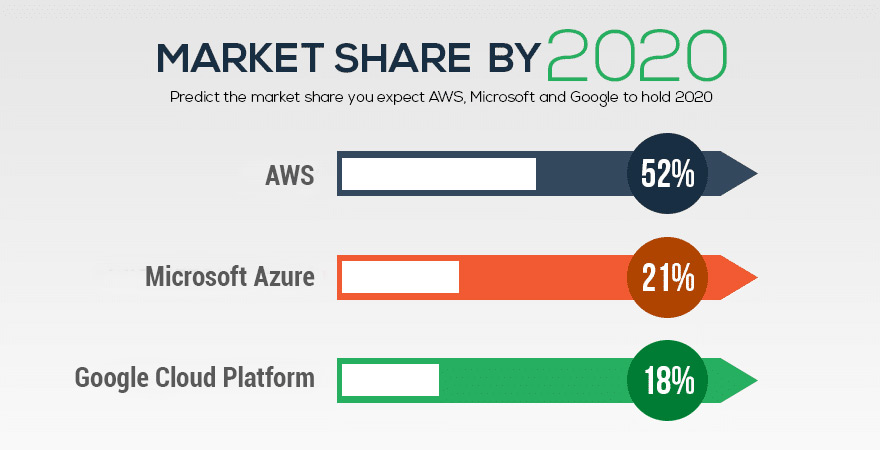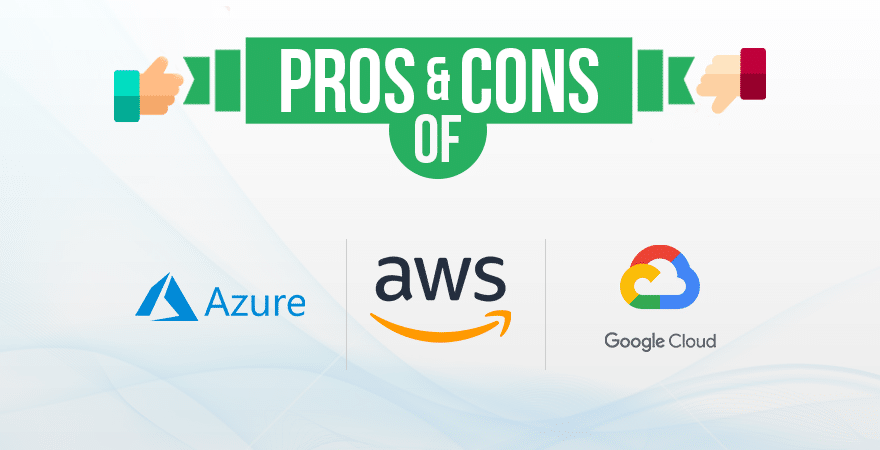2018 was the year Desktop-as-a-Service became the de facto solution choice for businesses workspaces and 2019 is the year of VDI. Cloud investments are skyrocketing. Cloud Vision’s 2020 survey shared how enterprises will host 83% of their workloads in the cloud by the year 2020 and Gartner believes 80% of companies will close their traditional data centers by 2025. Additionally, it is anticipated that businesses will put in over $57 billion (a 21% increase) in cloud infrastructure.
The writing is on the wall. The question is not if, but when, your business will move your workspaces to the cloud.
The Big 3: AWS, Azure, and Google
Chances are if you have been researching cloud workspace providers, you have consistently run across three names: AWS (Amazon Web Services), Microsoft Azure, and Google Cloud.

AWS will win the Market Share In the coming Year
As you can see, AWS has the lion’s share of the market as it stands today. AWS has been a pioneer in the cloud solutions industry, but there are many new names who are making a good play into the market, including Microsoft, Google, and even dinCloud’s own dinDaaS solution. Let’s take a look at the pros and cons of the leading solutions and close with a few thoughts as to why dinDaaS is making strides to challenge the contenders.

Pros & Cons of Amazon Web Services (AWS)
| Pros of Amazon Web Services | Cons of Amazon Web Services |
|---|---|
| Platform & language agnostic | Amazon EC2 has had reported reliability issues |
| Flexible | Complex end-user security protocols |
| Instantly Scalable | Tech support is on a fee basis |
| Enables rapid deployment | Limited instance controls |
| Pay-per-use and pay-as-you-go pricing models | Confusing billing structurePros & Cons of Microsoft Azure |
| AWS shared responsibility model, helping increase your security | N/A |
| Easy digital infrastructure transition | N/A |
| Support for a wide variety of services and applications for any business | N/A |
| Frequent updates of available services, features, and applications | N/A |
| User-friendly support | N/A |
Pros & Cons of Microsoft Azure
In 2008, Microsoft announced Azure, or code name “Project Red Dog,” with the purpose of building, deploying, testing and managing applications and services through Microsoft’s servers. Officially launched in 2010, Azure quickly made a name for itself in the platform industry, although still lagging significantly behind AWS.
| Few pros of Azure | Few cons of Azure |
|---|---|
| Highly available | Requires internal staff knowledge to manage/steep learning curve |
| Good scalability | Vendor lock-in – must put all eggs in one basket |
| Cost-Effective | Speed is an issue for some |
| Multiple redundancies to maintain data access | Ease of access can be challenging |
| Language agnostic, enabling you to code with the language you prefer | Requires significant platform expertise |
| Language agnostic, enabling you to code with the language you prefer | Poor DevOps support |
| Automate repetitive tasks | N/A |
| Easy to build a hybrid infrastructure | N/A |
| Frequent updates of available services, features, and applications | N/A |
| Access to AIl | N/A |
Pros & Cons of Google Cloud Services
Also in 2008, Google Cloud entered the market, and while this solution is lagging behind both AWS and Azure, it is making strides forward and holds it’s own against the other industry giants. With the continued investment the provider is putting into the solution, it will continue to grow at exceptional rates in terms of market share.
| Few pros of Google Cloud | Few cons of Google Cloud |
|---|---|
| Engineering support and knowledge | Lack of more advanced features and services |
| Strong application container deployments | Fewer global locations |
| Specializes in Analytics, big data, and machine learning | N/A |
There is no “one-size-fits-all” solution, Choose the one which meets your requirements
Your business should have the freedom to choose – not only which platform you choose to partner with, but how you interact with that platform and what features you utilize. Most importantly, you should have complete control over your platform and what you pay for, as well as have transparency into your cloud bill. dinCloud’s solution was built with security, reliability, and transparency as the cornerstone of their technology. If you would like to learn more about how dinCloud’s dinDaaS can give you the flexibility and agility you need in a workspace solution, while enhancing the security and productivity of your solution, contact one of our cloud specialists today.
Don’t forget to Read These Also:


